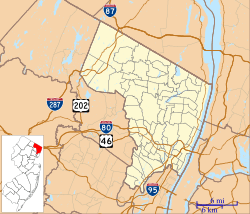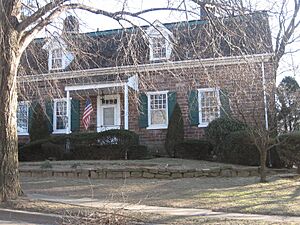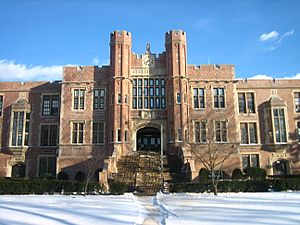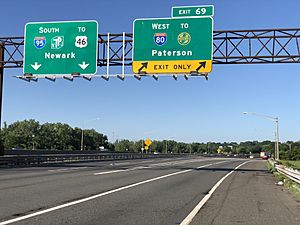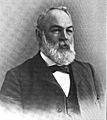Teaneck, New Jersey facts for kids
Quick facts for kids
Teaneck, New Jersey
|
||
|---|---|---|
|
Township
|
||
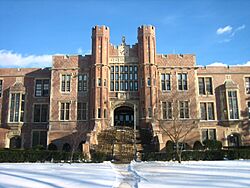
Teaneck High School
|
||
|
||
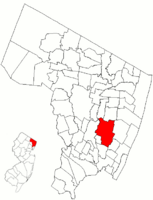
Location of Teaneck in Bergen County highlighted in red (right). Inset map: Location of Bergen County in New Jersey highlighted in red (left).
|
||
| Country | ||
| State | ||
| County | Bergen | |
| Incorporated | February 19, 1895 | |
| Government | ||
| • Type | Faulkner Act Council-Manager | |
| • Body | Township Council | |
| Area | ||
| • Total | 6.24 sq mi (16.15 km2) | |
| • Land | 6.04 sq mi (15.65 km2) | |
| • Water | 0.20 sq mi (0.51 km2) 3.16% | |
| Area rank | 253rd of 565 in state 7th of 70 in county |
|
| Elevation | 128 ft (39 m) | |
| Population
(2020)
|
||
| • Total | 41,246 | |
| • Estimate
(2023)
|
41,697 | |
| • Rank | 56th of 565 in state 2nd of 70 in county |
|
| • Density | 6,828.7/sq mi (2,636.6/km2) | |
| • Density rank | 70th of 565 in state 20th of 70 in county |
|
| Time zone | UTC−05:00 (Eastern (EST)) | |
| • Summer (DST) | UTC−04:00 (Eastern (EDT)) | |
| ZIP Code |
07666
|
|
| Area code(s) | 201 | |
| FIPS code | 3400372360 | |
| GNIS feature ID | 0882227 | |
Teaneck (/ˈtiːnɛk/) is a busy township in Bergen County, New Jersey. It's a "bedroom community," meaning many people who live here travel to work in the nearby New York metropolitan area. In 2020, Teaneck had a population of 41,246 people. This made it the second-largest town in Bergen County.
Teaneck became its own township on February 19, 1895. It was formed from parts of other townships like Englewood and Ridgefield. The people of Teaneck voted to become a separate town. This happened during a time when many towns in Bergen County were becoming "boroughs." But Teaneck chose to be a township instead.
The township is a major crossroads. It sits where Interstate 95 and Interstate 80 meet. Route 4 also cuts through the town. Teaneck has four main shopping areas: Cedar Lane, Teaneck Road, DeGraw Avenue, and West Englewood Avenue/Queen Anne Road (known as "The Plaza").
Because of its location by rivers, roads, and train lines, Teaneck has been important throughout history. After a battle in 1776, George Washington and his army retreated through Teaneck. They crossed the Hackensack River at New Bridge Landing, which is now a historic park. In 1965, Teaneck made history by choosing to integrate its public schools. This means they decided to have students of all backgrounds learn together. Teaneck is known for its diverse population, including large Jewish and African American communities.
Contents
Exploring Teaneck: A Rich History
The Beginnings of Teaneck
The exact meaning of the name "Teaneck" is a bit of a mystery. Some think it comes from Dutch or English words. Others believe it's a Native American word meaning "the woods."
Long ago, the Lenni Lenape Native American people had camps near what is now Queen Anne Road. A leader named Chief Oratam lived in a settlement by Overpeck Creek.
European settlers built homes along the Hackensack River as early as 1704. Other early homes were built along Teaneck Road. Many of these old Dutch stone houses from the 1700s are still standing today. Some are even on the National Register of Historic Places.
Teaneck During the Revolutionary War
In November 1776, George Washington and his army passed through Teaneck. This was after the Battle of Fort Lee. They were quickly retreating from the British army.
The Phelps Estate's Influence
Much of Teaneck's center used to be a huge property called the Phelps Estate. It had many paved roads and trails built by its owner, William Walter Phelps. When this estate was opened for development in 1927, it led to a big increase in Teaneck's population.
How Teaneck Became a Township
Teaneck officially became a Township on February 19, 1895. It took parts of Englewood Township, Ridgefield Township, and Bogota. At the time, many new towns were becoming "boroughs." But Teaneck chose to be a township.
In a vote on January 14, 1895, most voters wanted to become a borough. However, leaders from Englewood Township preferred Teaneck to be a township. So, a bill was passed, and Teaneck became an independent township.
When Teaneck first started, it had 811 people. William Weaver Bennett, who managed the Phelps Estate, became the first mayor. Early efforts focused on building streets, streetlights, and trolley lines.
Growth in the Early 1900s
The completion of the George Washington Bridge in 1931 connected Teaneck to Route 4. This brought many new families to the area. Between 1920 and 1930, Teaneck's population almost quadrupled. It grew from 4,192 to 16,513 people.
This fast growth caused some financial problems. So, in 1930, the town decided to adopt a new Council-Manager government. This system hired a full-time Town Manager, Paul A. Volcker Sr. He managed the town's daily business. During his 20 years in charge, he helped organize the town's money and development. He also created a professional fire department.
Teaneck After World War II
After World War II, Teaneck grew even more. In 1949, the United States Army chose Teaneck as "America's model community." They praised its good community spirit and government services. Photos and a film about Teaneck life were shown in other countries to teach about democracy.
In 1953, Fairleigh Dickinson University expanded its campus to Teaneck. This brought more students and growth to the town.
By the 1960s, the African American population in Teaneck grew. In 1965, Teaneck made a big step. It became the first community in the nation where a white majority voted to integrate its schools. This meant schools would welcome students of all races, without a court order. This important event was even written about in a book.
Today, Teaneck is home to many different groups of people. It has a large number of Modern Orthodox Jews. They have built many synagogues and yeshivas (Jewish schools). Teaneck also has many kosher shops, making it a center for the Orthodox Jewish community in northern New Jersey.
Historic Homes in Teaneck
Teaneck has several old homes that date back to the colonial era. These homes have been preserved and are still standing. Some of these historic sites include:
- John Ackerman House – Built between 1734 and 1787.
- Banta-Coe House – From the 18th century.
- Brinkerhoff-Demarest House – Built around 1728.
- Adam Vandelinda House – Built in 1830.
- Zabriskie-Kipp-Cadmus House – Built around 1751.
Teaneck's Location and Surroundings
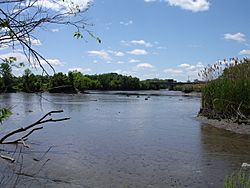
Teaneck covers about 6.24 square miles (16.15 square kilometers). Most of this is land, with a small part being water.
Teaneck is surrounded by eight other towns in Bergen County. To the west, across the Hackensack River, are River Edge and Hackensack. To the north are New Milford and Bergenfield. To the east are Englewood and Leonia. To the south are Ridgefield Park and Bogota.
People and Cultures in Teaneck
| Historical population | |||
|---|---|---|---|
| Census | Pop. | %± | |
| 1900 | 768 | — | |
| 1910 | 2,082 | 171.1% | |
| 1920 | 4,192 | 101.3% | |
| 1930 | 16,513 | 293.9% | |
| 1940 | 25,275 | 53.1% | |
| 1950 | 33,772 | 33.6% | |
| 1960 | 42,085 | 24.6% | |
| 1970 | 42,355 | 0.6% | |
| 1980 | 39,007 | −7.9% | |
| 1990 | 37,825 | −3.0% | |
| 2000 | 39,260 | 3.8% | |
| 2010 | 39,776 | 1.3% | |
| 2020 | 41,246 | 3.7% | |
| 2023 (est.) | 41,697 | 4.8% | |
| Population sources: 1900–1920 1900–1910 1910–1930 1900–2020 2000 2010 2020 |
|||
Most people in Teaneck speak English at home (72.4%). However, over a quarter of residents speak other languages. These include Spanish (14.5%), Tagalog (2.3%), Urdu (1.8%), Korean (1.0%), and Polish (1.0%).
Teaneck has a large Jewish community. In 2018, about 15,000 Jewish residents lived in Teaneck. Many of them are Modern Orthodox Jews. This community is very active and supports Israel.
Teaneck's Population Over Time
Teaneck's population grew very quickly in the first half of the 20th century. It changed from a quiet rural area to a busy suburb. This growth was especially fast after the Phelps Estate was developed in the late 1920s.
After World War II, Teaneck continued to grow. By 1970, it reached its highest population of 42,355. Since then, the population has stayed fairly stable. This is because there isn't much empty land left to build new homes.
Teaneck's Economy and Businesses
Teaneck is home to important places like Holy Name Medical Center and Fairleigh Dickinson University. The Teaneck Armory is where the New Jersey National Guard's 50th Main Support Battalion is located.
Cognizant Technology Solutions, a big technology company, has its main office in Teaneck. It's located in the Glenpointe Centre. This center also has a large Marriott Hotel and many office spaces.
Teaneck has four main shopping areas: Cedar Lane, north Teaneck Road, West Englewood Avenue/The Plaza, and Queen Anne Road/DeGraw Avenue. Cedar Lane had a big improvement project in 2006. It added new sidewalks, lighting, and plants to make the area more attractive for businesses and shoppers.
Arts and Culture in Teaneck
The Puffin Foundation helps support and create art in Teaneck. They sponsor plays and art shows at their Puffin Cultural Forum.
The Ethical Culture Society of Bergen County is also in Teaneck. They focus on ethical living and community service.
The Teaneck Community Band performs outdoor concerts every summer. The Bergen Philharmonic Orchestra, founded in 1938, also performs in Teaneck.
The Garage Theatre Group and Teaneck New Theatre put on professional plays. Black Box Studios is a theater group for children and teens.
Teaneck Cinemas is the town's movie theater. It was built in 1937 and has an Art Deco style. It hosts the Teaneck International Film Festival and the Northeast Film Festival.
Many films have been shot in Teaneck, including The Family Man (2000) and Armageddon Time (2022). The Teaneck Armory has also been used for movie scenes.
The famous African American music group The Isley Brothers started their record label, T-Neck Records, named after Teaneck. Other musicians from Teaneck include the rock band The Wrens and rappers DMX and The Notorious B.I.G..
Sports and Recreation in Teaneck
The Brooklyn Nets professional basketball team actually started in Teaneck! They were called the New Jersey Americans in 1967–1968. They played their home games at the Teaneck Armory for one season.
In 1977, Teaneck hosted a national youth basketball tournament. A team from New Orleans won the championship.
Fairleigh Dickinson University has some of its sports facilities in Teaneck. Their University Stadium, used for soccer, is located by the Hackensack River. The school also has the Naimoli Family Baseball Complex.
Parks and Green Spaces
Teaneck has 24 town parks. Votee Park is the largest, covering over 40 acres. It has baseball fields, soccer fields, playgrounds, and a swimming pool.
The Friends of the Hackensack River Greenway work to protect a 3.5-mile greenway along the Hackensack River. This area has native plants and is a nice place for walking. In 2009, this greenway became a National Recreation Trail.
The Teaneck Creek Conservancy has cleaned up a piece of land near Interstates 80 and 95. They have created 1.3 miles of trails there.
Overpeck County Park is a large park along Overpeck Creek. Teaneck donated about 500 acres to this park.
Education in Teaneck
Public Schools
The Teaneck Public Schools serve students from pre-kindergarten through high school. The district has eight schools. These include:
- Bryant School (Pre-K and Kindergarten)
- Theodora Smiley Lacey School (Kindergarten)
- Hawthorne School (Grades 1–4)
- Lowell School (Grades 1–4)
- Whittier School (Grades 1–4)
- Benjamin Franklin Middle School (Grades 5–8)
- Thomas Jefferson Middle School (Grades 5–8)
- Teaneck High School (Grades 9–12)
Teaneck High School has a high graduation rate. Students in Teaneck can also attend special programs at the Bergen County Technical Schools. These include the Bergen County Academies and the Bergen Tech campus.
The Teaneck Community Charter School (TCCS) is another public school option. It operates independently and offers a unique learning style.
Private Schools
Teaneck is home to the Metropolitan Campus of Fairleigh Dickinson University. This is a large private university.
There are also several private Orthodox Jewish day schools and high schools in Teaneck. These include Torah Academy of Bergen County (for boys) and Ma'ayanot Yeshiva High School (for girls). SINAI Special Needs Institute helps students with learning disabilities. Yeshivat He'atid is a K–8 Jewish day school that uses a blended learning model.
The Community School helps students with learning and attention challenges.
Al-Ghazaly High School used to be in Teaneck and served the Muslim community. It moved to Wayne, New Jersey. The Teaneck building is now the Academy of Greatness and Excellence, which is also an Islamic school for younger students.
Public Services in Teaneck
The Richard Rodda Community Center is a large community and recreation center. It has gyms, a dance studio, and rooms for many activities. The Teaneck Recreation Department offers sports and arts programs. The center also has a Senior Citizens Service Center.
Police and Fire Departments
The Teaneck Police Department has many officers and staff. They work to keep the community safe. The department received a special accreditation in 2012 for meeting high standards.
The Teaneck Volunteer Ambulance Corps (TVAC) has been providing emergency ambulance service since 1939. It has over 100 volunteers.
Medical Services
Holy Name Medical Center is a large community hospital in Teaneck. It was founded in 1925. The hospital works with NewYork-Presbyterian Healthcare System to offer many health care services. Holy Name Medical Center also has a special "Korean Medical Program" and offers services for the Orthodox Jewish community, like a Shabbat elevator and kosher food.
Getting Around Teaneck
Teaneck has many roads, including major highways. The New Jersey Turnpike (part of Interstate 95) runs through the town. Teaneck is also the eastern end of Interstate 80, which goes all the way to San Francisco.
NJ Route 4 crosses Teaneck from east to west. Unlike other towns along this highway, Teaneck keeps the area along Route 4 green and free of billboards.
You can easily get to New York City from Teaneck. You can use the George Washington Bridge in Fort Lee or the Lincoln Tunnel in Hudson County.
County roads in Teaneck include Teaneck Road, Queen Anne Road, River Road, and Cedar Lane.
Public Transportation Options
NJ Transit buses provide frequent service in Teaneck. You can take buses to the Port Authority Bus Terminal or the George Washington Bridge Bus Station in Manhattan. There are also buses to other New Jersey towns.
While there are no passenger trains in Teaneck right now, you can find train service nearby. The New Bridge Landing station and Anderson Street station offer NJ Transit train service to Hoboken Terminal. From Hoboken, you can connect to the PATH train to New York City.
Teaneck is also close to several airports. Newark Liberty International Airport is about 20 miles away. New York City's LaGuardia Airport and John F. Kennedy International Airport are also within reach. Teterboro Airport offers flights for smaller planes.
Images for kids
-
A view of the Hackensack River, taken from the shore in Teaneck
See also
 In Spanish: Teaneck (Nueva Jersey) para niños
In Spanish: Teaneck (Nueva Jersey) para niños



